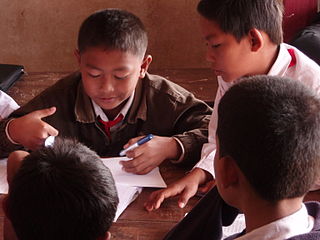Related Research Articles

Acting is an activity in which a story is told by means of its enactment by an actor or actress who adopts a character—in theatre, television, film, radio, or any other medium that makes use of the mimetic mode.

Aphasia is an inability to comprehend or formulate language because of damage to specific brain regions. The major causes are stroke and head trauma; prevalence is hard to determine but aphasia due to stroke is estimated to be 0.1–0.4% in the Global North. Aphasia can also be the result of brain tumors, brain infections, or neurodegenerative diseases.

Public speaking, also called oratory or oration, has traditionally meant the act of speaking face to face to a live audience. Today it includes any form of speaking to an audience, including pre-recorded speech delivered over great distance by means of technology.
Stuttering, also known as stammering, is a speech disorder in which the flow of speech is disrupted by involuntary repetitions and prolongations of sounds, syllables, words, or phrases as well as involuntary silent pauses or blocks in which the person who stutters is unable to produce sounds. The term stuttering is most commonly associated with involuntary sound repetition, but it also encompasses the abnormal hesitation or pausing before speech, referred to by people who stutter as blocks, and the prolongation of certain sounds, usually vowels or semivowels. According to Watkins et al., stuttering is a disorder of "selection, initiation, and execution of motor sequences necessary for fluent speech production". For many people who stutter, repetition is the main concern. The term "stuttering" covers a wide range of severity, from barely perceptible impediments that are largely cosmetic to severe symptoms that effectively prevent oral communication. Almost 70 million people worldwide stutter, about 1% of the world's population.

Attention deficit hyperactivity disorder (ADHD) is a neurodevelopmental disorder characterized by excessive amounts of inattention, carelessness, hyperactivity, and impulsivity that are pervasive, impairing, and otherwise age-inappropriate. Some individuals with ADHD also display difficulty regulating emotions and have executive dysfunction. For a diagnosis, the symptoms have to cause problems in at least two settings for over six months. In children, problems paying attention may result in poor school performance. ADHD is also associated with other mental disorders and substance use disorders, which can cause additional impairment, especially in modern society. Although people with ADHD struggle to focus on tasks they are not particularly interested in completing, they are often able to maintain an unusually prolonged and intense level of attention for tasks they do find interesting or rewarding; this is known as hyperfocus.

The fourth wall is a performance convention in which an invisible, imagined wall separates actors from the audience. While the audience can see through this wall, the convention assumes the actors act as if they cannot. From the 16th century onward, the rise of illusionism in staging practices, which culminated in the realism and naturalism of the theatre of the 19th century, led to the development of the fourth wall concept.
Relationship Development Intervention (RDI) is a trademarked proprietary treatment program for autism spectrum disorders (ASD), based on the belief that the development of dynamic intelligence is the key to improving the quality of life for autistic people. The program's core philosophy is that autistic people can participate in authentic emotional relationships if they are exposed to them in a gradual, systematic way. The goal of treatment is to systematically build up the motivation and tools for successfully interacting in social relationships, to correct deficits in this area that are thought to be common to all autistic people.

Stage fright or performance anxiety is the anxiety, fear, or persistent phobia which may be aroused in an individual by the requirement to perform in front of an audience, real or imagined, whether actually or potentially. Performing in front of an unknown audience can cause significantly more anxiety than performing in front of familiar faces. In some cases, the person will suffer no such fright from this, while they might suffer from not knowing who they're performing to. In some cases stage fright may be a part of a larger pattern of social phobia, but many people experience stage fright without any wider problems. Quite often, stage fright arises in a mere anticipation of a performance, often a long time ahead. It has numerous manifestations: stuttering, tachycardia, tremor in the hands and legs, sweaty hands, facial nerve tics, dry mouth, and dizziness.
Extemporaneous Speaking is a speech delivery style/speaking style, and a term that identifies a specific forensic competition. The competition is a speech event based on research and original analysis, done with a limited-preparation; in the United States those competitions are held for high school and college students. In a Extemporaneous Speech competition, enrolled participants prepare for thirty minutes on a question related to current events and then give a seven-minute speech responding to that question. The extemporaneous speaking delivery style, referred to as “off-the-cuff”, is a type of delivery method for a public presentation, that was carefully prepared and practiced but not memorized.
Cluttering is a speech and communication disorder characterized by a rapid rate of speech, erratic rhythm, and poor syntax or grammar, making speech difficult to understand.

Dramaturgy is a sociological perspective commonly used in micro-sociological accounts of social interaction in everyday life.
The floortime or Developmental, Individual-differences, Relationship-based (DIR) model is a developmental model for assessing and understanding any child's strengths and weaknesses. It has become particularly effective at identifying the unique developmental profiles and developing programs for children experiencing developmental delays due to autism, autism spectrum disorders, or other developmental disorders. This Model was developed by Dr. Stanley Greenspan and first outlined in 1979 in his book Intelligence and Adaptation. Evidence for the efficacy of DIR/Floortime includes results from randomized controlled trials of DIR/Floortime and the DIR/Floortime-based P.L.A.Y. Project; because of various limitations in these studies, the existing evidence is deemed to "weakly support" the efficacy of Floortime.
Collaborative methods are processes, behaviors, and conversations that relate to the collaboration between individuals. These methods specifically aim to increase the success of teams as they engage in collaborative problem solving. Forms, rubrics, charts and graphs are useful in these situations to objectively document personal traits with the goal of improving performance in current and future projects.

Learning disability, learning disorder, or learning difficulty is a condition in the brain that causes difficulties comprehending or processing information and can be caused by several different factors. Given the "difficulty learning in a typical manner", this does not exclude the ability to learn in a different manner. Therefore, some people can be more accurately described as having a "learning difference", thus avoiding any misconception of being disabled with a lack of ability to learn and possible negative stereotyping. In the United Kingdom, the term "learning disability" generally refers to an intellectual disability, while difficulties such as dyslexia and dyspraxia are usually referred to as "learning difficulties".
Tandem language learning is a method of language learning based on mutual language exchange between tandem partners, where ideally each learner is a native speaker in the language the other person wants to learn. The tandem language learning experience steps away from the traditional learning pedagogy, removing the teacher-student model. Many language schools in the world, organized as TANDEM International, as well as many universities, implement this approach.
The Applied Neuroscience Society of Australasia (ANSA) is a non-profit professional organization for applied neuroscience in Australia, with members in Australia, New Zealand and Asia.
Stuttering therapy is any of the various treatment methods that attempt to reduce stuttering to some degree in an individual. Stuttering can be a challenge to treat because there is a lack of evidence-based consensus about therapy. Some believe that there is no cure for the condition.

An actor or actress is a person who portrays a character in a performance. The actor performs "in the flesh" in the traditional medium of the theatre or in modern media such as film, radio, and television. The analogous Greek term is ὑποκριτής (hupokritḗs), literally "one who answers". The actor's interpretation of a role—the art of acting—pertains to the role played, whether based on a real person or fictional character. This can also be considered an "actor's role," which was called this due to scrolls being used in the theaters. Interpretation occurs even when the actor is "playing themselves", as in some forms of experimental performance art.

Surtitles, also known as supertitles, SurCaps, OpTrans, are translated or transcribed lyrics/dialogue projected above a stage or displayed on a screen, commonly used in opera, theatre or other musical performances. The word "surtitle" comes from the French language "sur", meaning "over" or "on", and the English language word "title", formed in a similar way to the related and similary-named subtitle. The word Surtitle is a trademark of the Canadian Opera Company.
Selective auditory attention or selective hearing is a type of selective attention and involves the auditory system. Selective hearing is characterized as the action in which people focus their attention intentionally on a specific source of a sound or spoken words. When people use selective hearing, noise from the surrounding environment is heard by the auditory system but only certain parts of the auditory information are chosen to be processed by the brain.
References
- ↑ Anon. (2001), The value of Speaking Circles for those who stammer, British Stammering Association, retrieved 2008-07-31
- ↑ Dr. Marilyn Kroplick, Speaking Circles Applied to Attention Deficit Disorder (ADD), New Horizons for Learning, retrieved 2008-07-31
- ↑ Lee Glickstein (1999), Be Heard Now!, Broadway